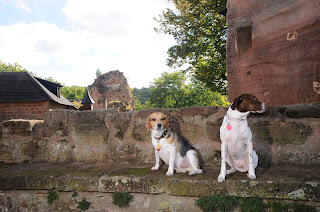Mo “Well it has been a bit since we spoke about stuff.”
Sa “True. It has been hot. Also pop pop and mom have been
busy doing other things.”
Sa “We did go to Central Park again. Do you remember what we
discovered?”
Mo “Mmmm. We saw a bunch of humans. Passed a lot of hot dogs
and food carts. But pop pop and mom packed our own snacks this time.”
Sa “You don’t remember the castle?”

Mo “Oh yea. It wasn’t as big as some of the ones while we
lived with the white hot dogs”
Sa “Those were bratwursts and it was in Germany.”
Mo “Yep that was some good food and big castles.”
Sa “So true but do not sell the one in central park short it
is really neat considering.”
Mo “Considering what?”
Sa “Glad you asked let me give you the history lesson for
this week.”
Mo “Oh no fair you set me up for that one.”
Sa “Indeed I did. Originally designed in 1865 by two people
named Calvert Vaux and Jacob Wrey Mould. Belvedere Castle was intended to be a
Victorian Folly, a fantasy structure that provides a great backdrop and views
however there was no real purpose for the building itself.”
Mo “Really? When space is important people did not live in
this castle?”
Sa “Good question, no with a strong stone façade, grand
turret and flag, the castle was meant to be just a stunning attraction in
Central Park.”
Mo “What about the other side that does not look like the
other castles we have seen?”
Sa “Honestly, you are hot today. The original plans for the
building included another elaborate two-story structure on the site of today’s
pavilion, but money concerns stopped construction and left the castle in its
present state.”
Mo “Do they use the castle for something else now?”
Sa “In 1919 the United States Weather Bureau moved the
Central Park Observatory to the castle. Before that weather measurements were
taken from the Arsenal at Fifth Avenue and 64th Street. The Weather Bureau
enclosed the castle and altered the turret’s shape to accommodate their
scientific instruments.”
Mo “I didn’t see big electric stuff or monitors there?”
Sa “There is a reason for that. They closed that part in the
early 1960’s. The empty building was left to deteriorate until 1983, when the
Central Park Conservancy replaced the original turret, rebuilt the pavilions, and
converted the castle into a visitor’s center. The Henry Luce Nature Observatory
in the castle, created in 1996, provides interactive nature exhibits inside the
castle as well as bird-watching kits, which can be used throughout the park.”
Mo “In the end of it all your saying if you get the chance
take the time to come see the castle in Central Park.”
Sa “Definitely. It is worth the walk.”























